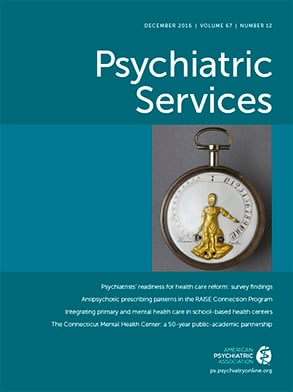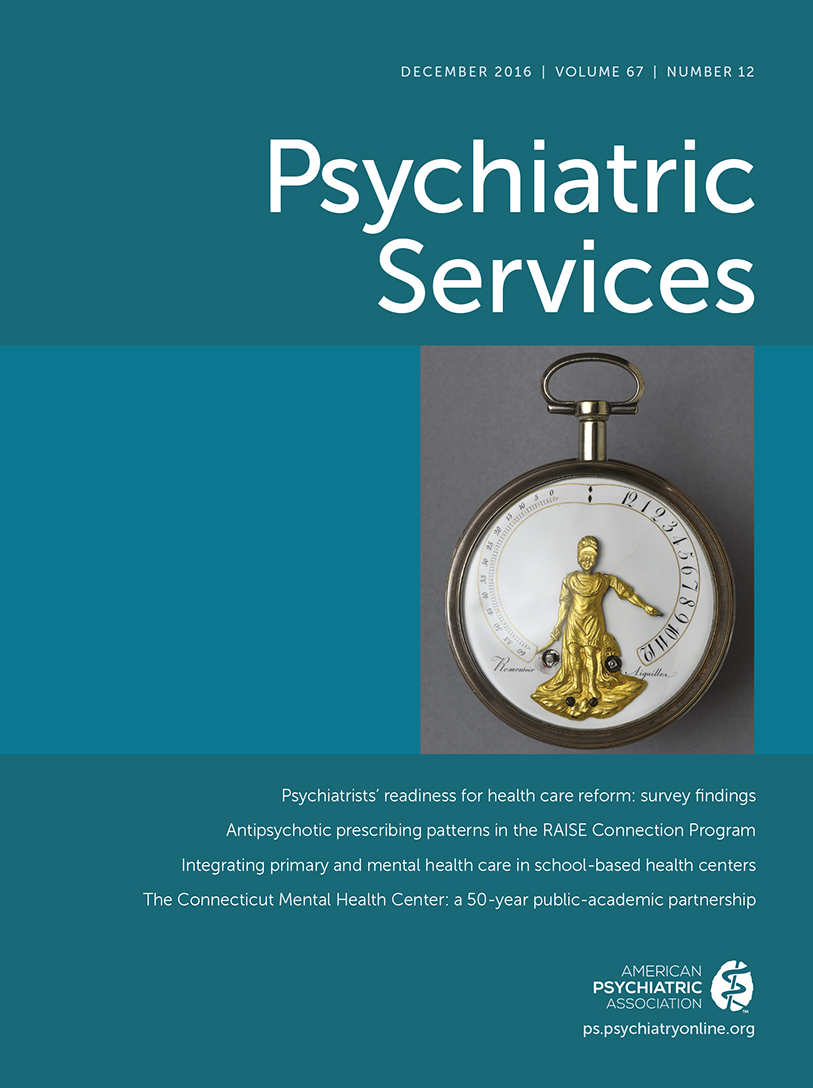Depression is the second most common chronic condition treated by primary care providers, with an estimated 12% of primary care patients experiencing major depression (
1,
2). Despite the prevalence of depression and the availability of effective evidence-based treatments, most depressed patients do not have adequate treatment outcomes. In primary care, the most common treatment for depression is antidepressant medications (
3), with second-generation antidepressants accounting for over 90% of prescriptions for depression among primary care patients (
4). However, in a study by Solberg and colleagues (
5), only 50% of primary care patients who received antidepressants as their main treatment demonstrated improvement after three months, and 15% experienced increased depression severity. Another study, by Vuorilehto and colleagues (
6), found that only 25% of primary care patients with major depression achieved and maintained remission at 18 months. Clearly there is room for improvement in primary depression care.
Developing a clearer idea of which patients are least likely to respond to usual care may help providers to focus more intensive interventions, including stepped care or collaborative care, on these patients to improve their chances of recovering from depression. Prior research has shown that comorbid psychiatric (
7–
9) and general medical conditions (
10,
11), chronic pain (
7), early age of depression onset (
7,
9), recurrent depressive episodes (
9), severity of depression (
7,
9), and lower socioeconomic status (
12,
13) are predictors of poor depression remission or response. However, much of these data were collected as part of clinical trials with select patient populations or in psychiatric care settings rather than in primary care settings. The few studies of depression in primary care have been limited by selection bias, small sample sizes, and short follow-up times (
14). As part of evaluating a statewide effort to improve primary care of depression through a collaborative care initiative, we had the opportunity to evaluate a large group of primary care patients receiving usual care for depression prior to implementation of the new depression care model. This study determined which patient characteristics best predicted poor depression outcomes in primary care.
Results
A total of 792 primary care patients received usual care for depression (
Table 1). Patient ages ranged from 18 to 88, with a mean±SD age of 46±14 years. Women comprised 75% of patients, and most patients were white and had at least some college education. Over half of patients were in relationships, and two-thirds were employed. A majority reported a household income equal to at least twice the federal poverty level, and most reported good, very good, or excellent health.
At baseline, 255 (32%) patients had mild depression, 315 (40%) moderate depression, 161 (20%) moderately severe depression, and 61 (8%) severe depression, as measured by the PHQ-9. In addition to receiving primary care treatment of depression, 43 (5%) received treatment from a psychiatrist, 201 (25%) participated in individual psychotherapy, and 26 (3%) participated in group therapy; in all, 230 (29%) patients received some psychiatric or psychological treatment. This was the first episode of depression treatment for 307 (39%) patients, whereas 185 (23%) had been treated for one prior episode, and 300 (38%) had at least two prior episodes of depression. Over half of patients (N=445) felt that their functioning was impaired by at least 50% because of their health.
At six months, 47% of patients achieved a combined ordinal outcome of remission (N=292) or response (N=83). Health status was the most strongly associated with depression remission or response: patients who reported fair or poor health were significantly less likely to experience depression remission or response compared with patients with good, very good, or excellent health (OR=.58, model 1 [adjusted for baseline PHQ-9 score]; adjusted OR [AOR]=.63, model 2 [adjusted for all other variables in the model]) (
Table 2). Patients who were unemployed were also less likely to achieve remission or response (OR=.70), although this association was no longer significant in the fully adjusted model. Patients who had lower incomes or who were treated by a psychiatrist or psychotherapist tended to have lower rates of remission or response, but these associations did not achieve statistical significance. In contrast, although there was not a monotonic association between age and remission or response, we found that patients under age 35 were more likely to achieve remission or response compared with patients ages 35 to 49 (OR=1.46; AOR=1.49). Similarly, patients with mild depression were more likely to achieve depression remission or response compared with patients with severe depression (OR=2.16), but this association was no longer significant in the fully adjusted model.
Discussion
Our results from this large sample of primary care patients indicate that patients were significantly less likely to achieve depression remission or response at six months if their self-rated health status was poor or fair or if they were unemployed and were more likely to achieve remission or response if they were younger or had mild depression. Patients with lower incomes and those who received specialty mental health care tended to have lower rates of remission or response that did not reach statistical significance.
Poorer self-rated health was by far the strongest predictor of depression remission or response in our population and the only significant predictor in the fully adjusted model. Several studies have shown that adults with depression function poorly and that their level of functioning is on par with persons with chronic medical conditions such as cardiopulmonary disease, arthritis, hypertension, and diabetes (
19–
21). Studies also show that depression can prolong the recovery from certain medical illnesses and increase the risk of mortality (
22,
23). Further, depression can decrease energy and motivation and lead to poorer self-care behaviors (
24). Ultimately, patients with poorer health are more likely to develop depression (
25), and our study shows that these patients were also less likely to achieve depression remission or response as a result of usual care. Most primary care providers have easy access to patients’ problem lists or past medical histories, which, as surrogates for health status, have been found in other studies to be associated with poor depression outcomes (
26). In this manner, providers could identify patients who are less likely to respond to usual depression care. Even easier, perhaps, would be to ask patients to rate their own health, given that self-rated health was a robust predictor of depression remission or response in our sample.
Other predictors of poorer depression outcomes in our study included unemployment and lower income. A systematic review of observational studies in primary care similarly found lower education and unemployment to be significant risk factors for persistent depression (
14). Other studies have shown a correlation between unemployment, lower income, and the prevalence of depression (
27–
30). The relationship between depression and employment and income is thought to be bidirectional, with depression impairing one’s ability to obtain and maintain employment and income level, and unemployment and poverty increasing one’s risk of depression. In other research, poverty has been one of the most consistent predictors of depression (
31), and common correlates of low income (including a disadvantaged neighborhood, less access to educational and employment opportunities, and concerns about safety and resources) have significant detrimental effects on mental health beyond the direct effects of poverty itself (
32), particularly for women (
33,
34). We should note that in our sample, the association between employment and depression outcomes was no longer significant in the fully adjusted model, likely because this association was confounded with health status. Regardless, our results show that when disadvantaged people develop depression, their depression, unfortunately, is less likely to respond to usual care.
Overall, 53% of patients in our sample had persistent depression without remission or response at six months. This rate of nonresponse is consistent with the few other studies of usual care of depression in primary care, which have found nonresponse rates ranging from 24% to 81% at six to 12 months (
35–
40). This rate of continued depression is troublesome, particularly given the significant morbidity and mortality that accompany depression (
41,
42). It may be that providing more intense depression treatment for patients at higher risk of nonresponse—those with poor health, more severe depression, or unemployment or lower income—could improve these relatively dismal rates of improvement, and this is an area for future study.
Our study had several potential limitations. Although we interviewed patients within 21 days of their index prescription for depression, some may have responded to depression treatment by the time of the interview. This may have resulted in patients having lower PHQ-9 scores at baseline than they might have had at the time of treatment initiation, possibly excluding some otherwise eligible patients from our sample. We studied patients receiving usual care in their primary care clinics and thus could not control factors that we might have been able to control in a randomized controlled trial, such as additional treatment by mental health providers. Our sample included only patients who started antidepressant medications, and results cannot be generalized to other groups, such as patients receiving only psychotherapy or those who opted for no treatment. In addition, the generalizability of our data is limited by the fact that only 792 patients out of a potential sample of 11,889 patients completed our baseline and six-month surveys. Some of these patients were excluded because they did not have depression or could not complete the measures, but others were excluded because we were unable to reach them or they refused screening, and thus potential selection bias may have influenced our results. Further, it is likely that patients who were willing to participate in our surveys may have been less severely depressed and perhaps had better health status than patients who declined. Generalizability was also limited because our sample was predominantly white and of relatively high socioeconomic status.

